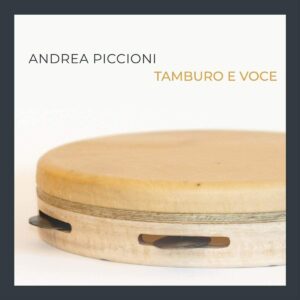
De Italiaanse musicus Andrea Piccioni bespeelt virtuoos diverse percussie-instrumenten waaronder de tamburo (soort tamboerijn), de bendir (Noord-Afrikaanse handtrommel) en kleine percussie zoals castagnetten en shakers.
English version below
Het album Tamburo e Voce is de debuut-CD van Italiaanse percussionist Andrea Piccioni. Hij is een veelgevraagd musicus die we al tegenkwamen bij accordeonist Riccardo Tesi, mandolinespeler Patrick Vaillant, zangeres Lucilla Galeazzi, saxofonist Gianluigi Trovesi en de Masters of Frame Drums. Op Tamburo e Voce plaatst hij zijn percussie-werk steeds in een ander perspectief. Zo opent het album met een door Piccioni gecomponeerde tarantella. Een snelle opzwepende dans (in 6/8ste maat) uit het zuiden van Italië (Puglia). In Canto sul Tamburo per la Madonna della Gallina klinkt de muziek uit Zuid-Frankrijk (Occitanië), met energieke voor- en nazang. Saltarello is weer een opzwepende dans, maar nu uit het midden van Italië. Verderop klinkt het Arabische aandoende Qustor Zulf (met Sirojiddin Juraev op de dutar: langhalsluit) en het Turkse Frunni d’Alia. Fraai hoe Andrea Piccioni zijn spel- en instrument-keuze aanpast aan de muziek en kiest tussen bendir en mondharp. Daarnaast maakt hij subtiel gebruik van shakers, samples en elektronica, maar het opvallendst is toch zijn spel op de tamburo. Op virtuoze wijze bespeelt hij het vel van het instrument en laat daarbij de kleine belletjes mee vibreren, waardoor er een opzwepend geluid en vlammend ritme ontstaat. Zoals in Braci en het verbluffende Kira samen met Haffner op de pandeiro (Noord-Spaanse tamboerijn). Piccioni wordt bijgestaan door een aantal musici waaronder de saxofonisten Pierfrancesco Mucari en Pierfrancesco Mucari, ûd (Arabische luit) en cümbüs-speler Yinon Muallem en Matthias Haffner op de Braziliaanse berimbau. Andrea Picciono ontpopt zich op zijn debuut-album Tamburo e Voce niet alleen als een veelzijdige virtuoze muzikant maar ook als een voortreffelijk componist die op enerverende wijze zijn muziek ten gehore brengt!
English version
The Italian musician Andrea Piccioni plays virtuoso various percussion instruments, including the tamburo (a kind of tambourine), the bendir (North African hand drum) and small percussion such as castanets and shakers.
The album Tamburo e Voce is the debut CD of the Italian percussionist Andrea Piccioni. He is a much sought-after musician who already played and recorded CD’s with accordionist Riccardo Tesi, mandolin player Patrick Vaillant, wonderful singer Lucilla Galeazzi, saxophonist Gianluigi Trovesi and the Masters of Frame Drums. On Tamburo e Voce he puts his percussion work in a different perspectives. The album opens with a tarantella composed by Piccioni. A fast rousing dance (in 6/8th measure) from the south of Italy (Puglia). Canto sul Tamburo per la Madonna della Gallina features music from the south of France (Occitanie), with energetic call- and respond vocals. Saltarello is another exciting dance, but this time from the middle of Italy. Further on you can hear the Arab-like Qustor Zulf (with Sirojiddin Juraev on the dutar: long-necked closing) and the Turkish Frunni d’Alia. Wonderful how Andrea Piccioni chooses between bendir or the jew’s harp and fits them organic in the music. In addition, he makes subtle use of shakers, samples and electronics, but the most striking is his playing on the tamburo. He plays the skin of the instrument in a virtuoso way, making the small bells vibrate along with it, creating a stirring sound and flaming rhythm. Like in Braci and the stunning piece Kira together with Haffner on the pandeiro (Northern Spanish tambourine). Piccioni is assisted by a number of musicians, including the saxophonists Pierfrancesco Mucari and Pierfrancesco Mucari, ûd (Arabic lute) and cümbüs player Yinon Muallem and Matthias Haffner on the Brazilian berimbau. Andrea Picciono emerges on his debut album Tamburo e Voce not only as a versatile virtuoso musician but also as an excellent composer who performs his music in an exciting way!
- Andrea Piccioni: Tamburo e Voce (Visage Music / Xango)
© Mattie Poels.

Geen reacties